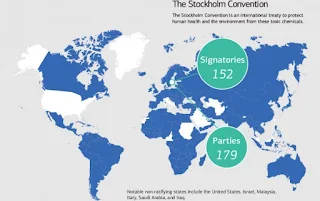What are PCBs?
Polychlorinated Byphenils, PCBs in short, are a group of man-made chemicals. PCBs have been widely used in the past, mainly in electronical equipments. The commercial production of PCBs started in 1929, but their use has been banned or restricted in many countries since the 1970s because of the possible risks to human health and environment.
PCBs are generally very stable, and are resistant to acids
and bases as well as to heat. They have been used as an insulating material in
electric equipment, such as transformers and capacitors. PCBs have also been
used in wide range of products such as plasticizers, surface coatings, inks,
and carbonless duplicating paper.
Since 1929 around 2 million tons of PCBs have been produced,
and about 10% of which still remain today because of their stability.
PCBs can persist in the environment and accumulate in animals and along the food-chain. Humans may be exposed to PCBs by ingesting contaminated food and water or inhaling contaminated air. In the human body PCBs can remain in fatty tissues
and in the liver and may be transferred from mother to child through
the placenta or breast milk. The speed at which PCBs are transformed in
the body and the extent to which they are either stored or excreted
depend on the type of PCB.
Studies on humans and animals have shown harmful effects on fertility. Furthermore,of the child during pregnancy or through breast-feeding can affect its development. Effects on the immune system have been observed in animals, in children exposed to PCBs during development in the womb, and in adults exposed through PCB-contaminated food. Groups of workers that have been exposed to high levels of PCBs
PCBs Regulations in Indonesia
In Indonesia, there is no regulations that specifically
regulates PCBs. PCBs are categorized as hazardous and toxic substances (limbah B3). In general, the regulations
can be found in Law No. 32/2009 about Environmental Protection Management, GR
No. 74/2001 on Hazardous Toxic and Substance Management, GR No. 101/2014 on
Hazardous Waste and Toxic Management.
Gap Analysis and Recommendations
However, there still are many holes in the term of PCBs, such as :
1. The existing regulations do not have clear definitions regarding articles and/or equipment containing/contaminated with PCBs as a hazardous materials.
2. They do not have clear status regarding articles and/prg equipment containing/contaminated with PCBs, whether should it be treated as hazardous waste, prohibited to be imported, or hazardous materials, etc.
3. There is no regulation that specifically prohibits, control, and regulate the distribution, and import of PCBs mixture, and equipment that containing/contaminated with PCBs to Indonesia, as GR No. 74/2001 only regulates about PCBs as chemicals.
4. There has not been guideline standard (e.g SNI) on regarding PCBs treshold limit in the equipment/articles.
5. The policy regarding to PCB management is not yet related with different sector and ministries
6. Lastly, there has not been any policy regarding unintentional release of PCB to the environments.
Regarding to those matters, we recommend :
1. For government to issue regulations that specifically prohibits the import of PCB (as chemical substance);
2.To clarify the status of articles and/or equipment containing/contaminated with PCBs. Whether should it be treated as hazardous waste, prohibited to be imported, etc.;
3. To formulate standard regarding the PCBs threshold limit in equipment/articles (especially in the consumer products);
4. To formulate a guideline regarding the environmentally sound management of PCBs (the technical one);
5. To formulate policy and measures to reduce or eliminate PCBs releases from unintentional production;
6. To discuss the role and function of B3 commission in this matter;
7. To discuss whether there is a discretion for specific ministry to prohibit the import/use/distribution of new PoP's subtance.
References :
Internal source
What are PCBs, accessed from http://www.greenfacts.org/en/pcbs/l-2/1-polychlorinated-biphenyls.htm#0 on Feb 6th, 2016







Recent Comments